Development and Implementation of Language Policy in Australia
VerifiedAdded on 2023/06/13
|16
|4256
|401
Essay
AI Summary
This essay provides an overview of language policy and planning (LPP) in Australia, emphasizing the significance of language in communication, cultural identity, and social development. It discusses key LPP concepts, implications, and the formulation of language policies by Australian public authorities, highlighting the need for a coordinated and balanced approach. The essay also delves into the guiding principles of language policy, including improving English competency, maintaining other languages, providing services in multiple languages, and offering second language learning opportunities. Furthermore, it examines the importance of national policies in a federal system, emphasizing consensus and coordination among various government bodies to achieve shared objectives related to language learning, maintenance, and bilingualism. This resource is available on Desklib, where students can find a wide array of academic materials and study tools.
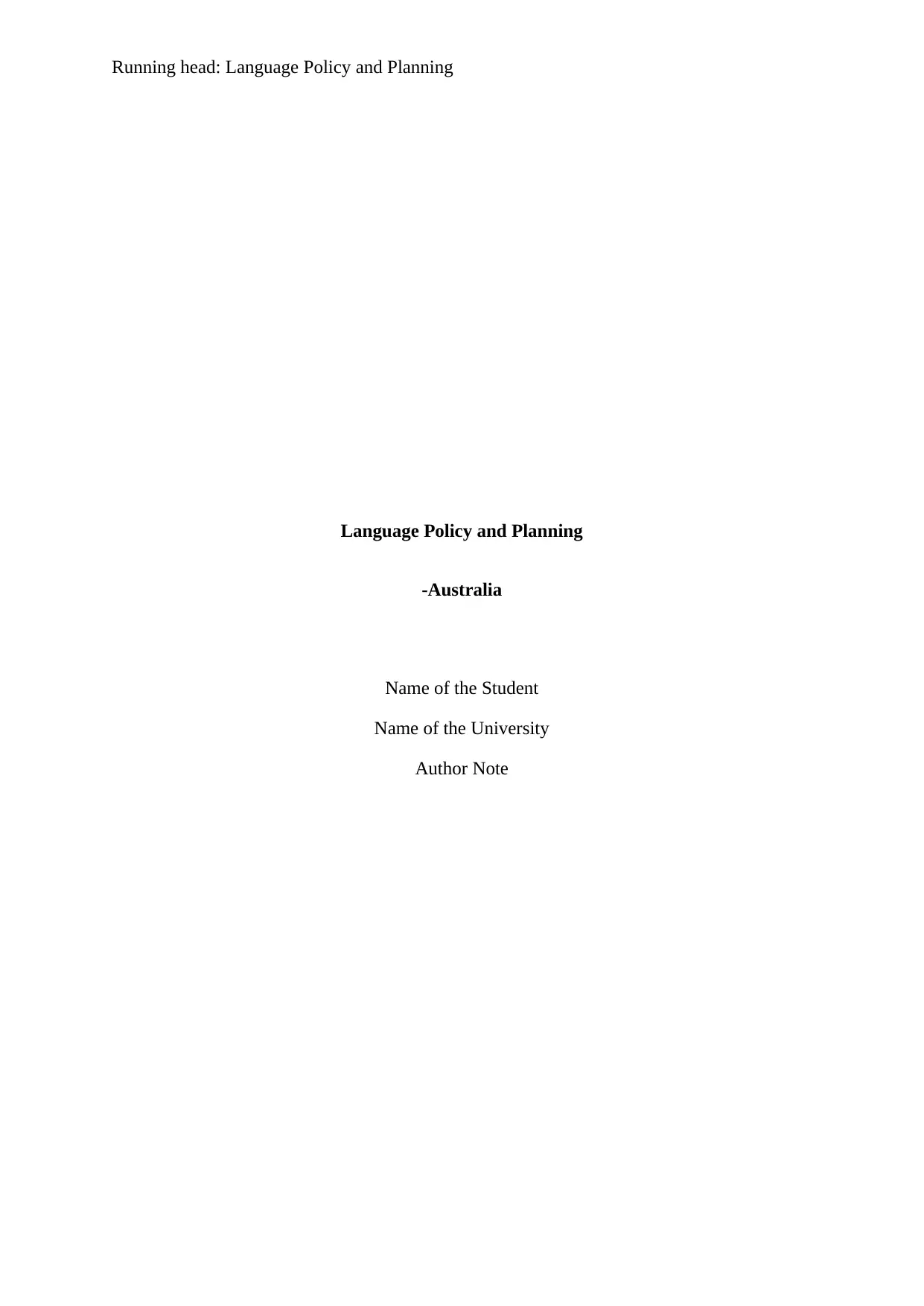
Running head: Language Policy and Planning
Language Policy and Planning
-Australia
Name of the Student
Name of the University
Author Note
Language Policy and Planning
-Australia
Name of the Student
Name of the University
Author Note
Paraphrase This Document
Need a fresh take? Get an instant paraphrase of this document with our AI Paraphraser
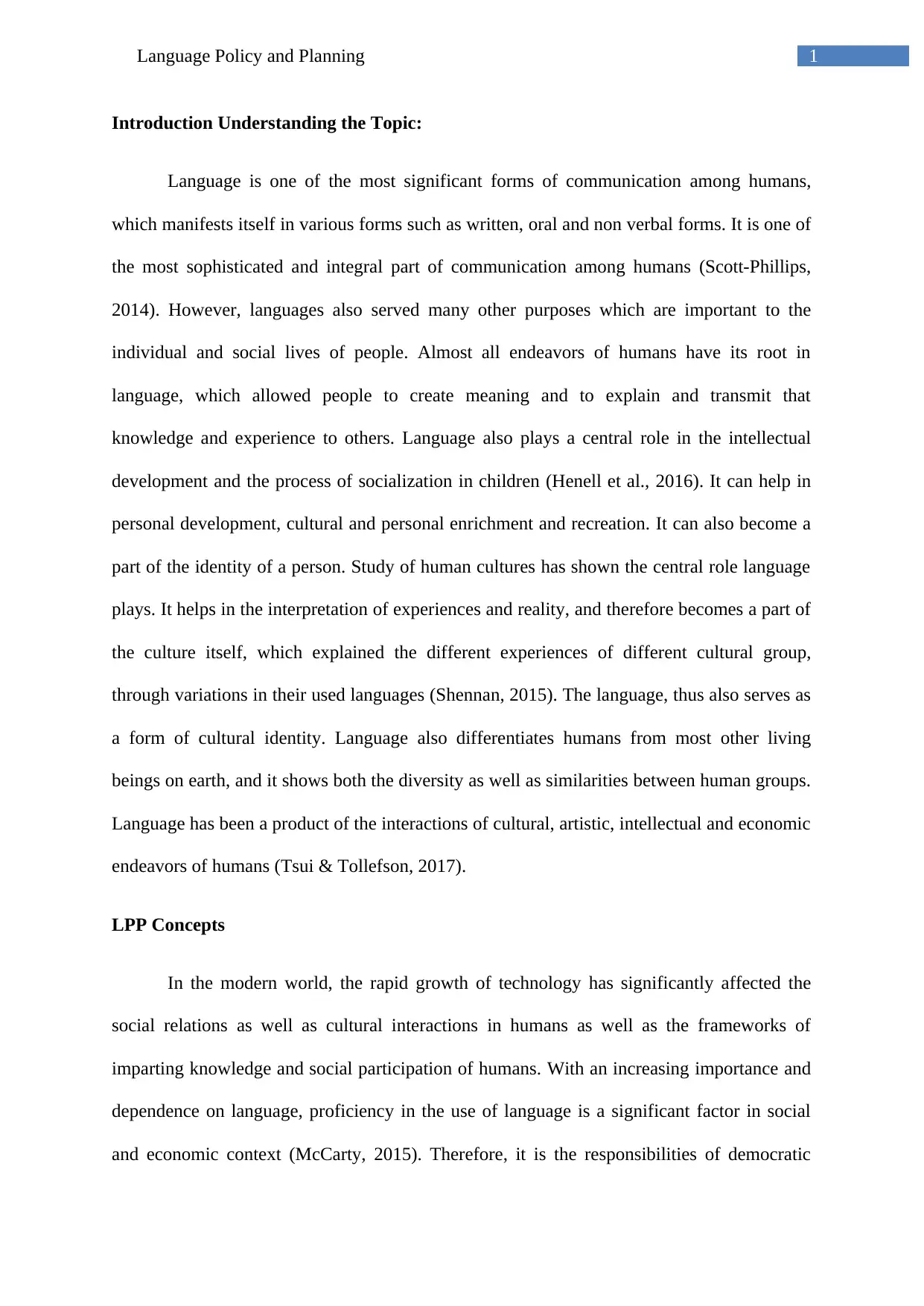
1Language Policy and Planning
Introduction Understanding the Topic:
Language is one of the most significant forms of communication among humans,
which manifests itself in various forms such as written, oral and non verbal forms. It is one of
the most sophisticated and integral part of communication among humans (Scott-Phillips,
2014). However, languages also served many other purposes which are important to the
individual and social lives of people. Almost all endeavors of humans have its root in
language, which allowed people to create meaning and to explain and transmit that
knowledge and experience to others. Language also plays a central role in the intellectual
development and the process of socialization in children (Henell et al., 2016). It can help in
personal development, cultural and personal enrichment and recreation. It can also become a
part of the identity of a person. Study of human cultures has shown the central role language
plays. It helps in the interpretation of experiences and reality, and therefore becomes a part of
the culture itself, which explained the different experiences of different cultural group,
through variations in their used languages (Shennan, 2015). The language, thus also serves as
a form of cultural identity. Language also differentiates humans from most other living
beings on earth, and it shows both the diversity as well as similarities between human groups.
Language has been a product of the interactions of cultural, artistic, intellectual and economic
endeavors of humans (Tsui & Tollefson, 2017).
LPP Concepts
In the modern world, the rapid growth of technology has significantly affected the
social relations as well as cultural interactions in humans as well as the frameworks of
imparting knowledge and social participation of humans. With an increasing importance and
dependence on language, proficiency in the use of language is a significant factor in social
and economic context (McCarty, 2015). Therefore, it is the responsibilities of democratic
Introduction Understanding the Topic:
Language is one of the most significant forms of communication among humans,
which manifests itself in various forms such as written, oral and non verbal forms. It is one of
the most sophisticated and integral part of communication among humans (Scott-Phillips,
2014). However, languages also served many other purposes which are important to the
individual and social lives of people. Almost all endeavors of humans have its root in
language, which allowed people to create meaning and to explain and transmit that
knowledge and experience to others. Language also plays a central role in the intellectual
development and the process of socialization in children (Henell et al., 2016). It can help in
personal development, cultural and personal enrichment and recreation. It can also become a
part of the identity of a person. Study of human cultures has shown the central role language
plays. It helps in the interpretation of experiences and reality, and therefore becomes a part of
the culture itself, which explained the different experiences of different cultural group,
through variations in their used languages (Shennan, 2015). The language, thus also serves as
a form of cultural identity. Language also differentiates humans from most other living
beings on earth, and it shows both the diversity as well as similarities between human groups.
Language has been a product of the interactions of cultural, artistic, intellectual and economic
endeavors of humans (Tsui & Tollefson, 2017).
LPP Concepts
In the modern world, the rapid growth of technology has significantly affected the
social relations as well as cultural interactions in humans as well as the frameworks of
imparting knowledge and social participation of humans. With an increasing importance and
dependence on language, proficiency in the use of language is a significant factor in social
and economic context (McCarty, 2015). Therefore, it is the responsibilities of democratic
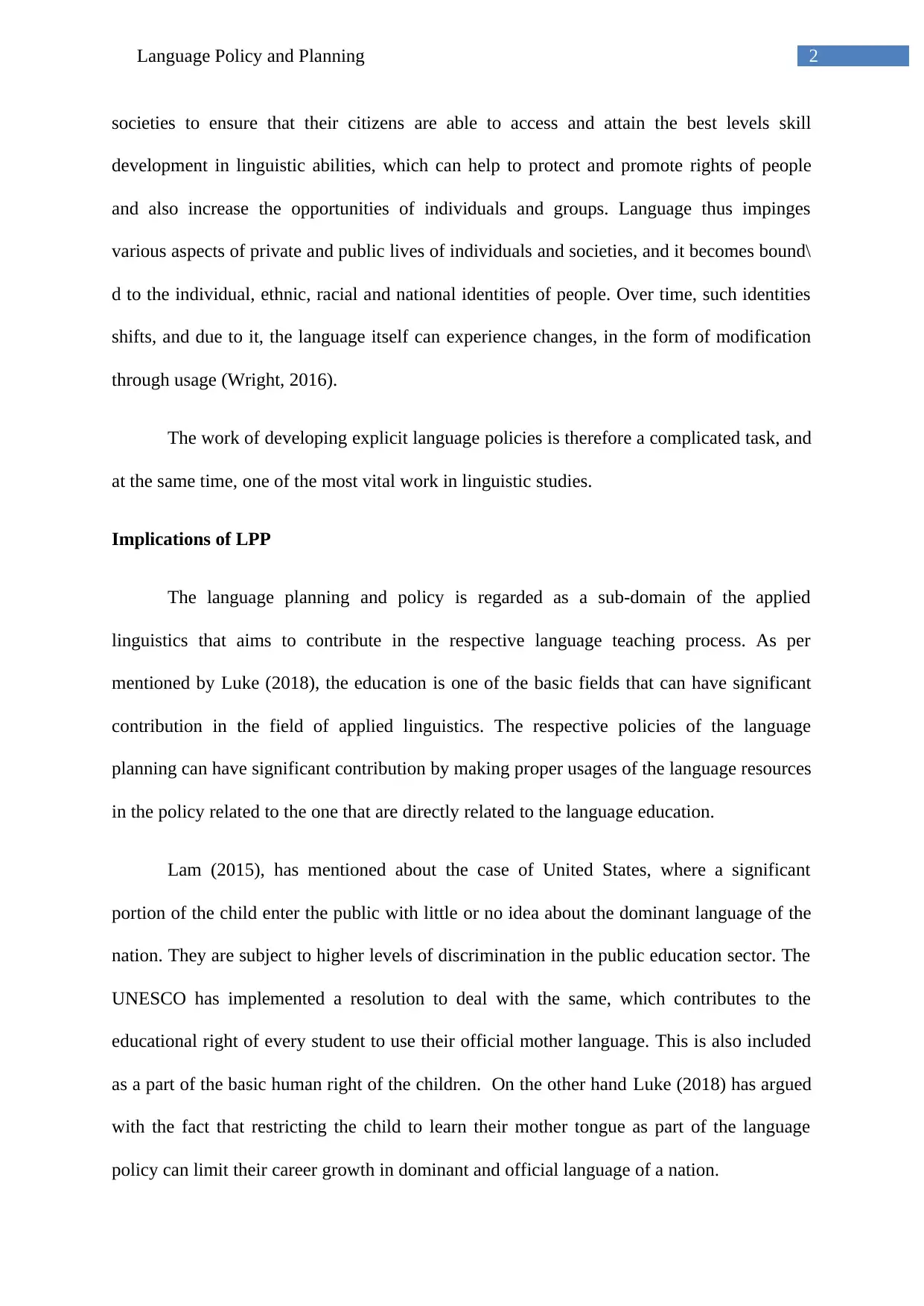
2Language Policy and Planning
societies to ensure that their citizens are able to access and attain the best levels skill
development in linguistic abilities, which can help to protect and promote rights of people
and also increase the opportunities of individuals and groups. Language thus impinges
various aspects of private and public lives of individuals and societies, and it becomes bound\
d to the individual, ethnic, racial and national identities of people. Over time, such identities
shifts, and due to it, the language itself can experience changes, in the form of modification
through usage (Wright, 2016).
The work of developing explicit language policies is therefore a complicated task, and
at the same time, one of the most vital work in linguistic studies.
Implications of LPP
The language planning and policy is regarded as a sub-domain of the applied
linguistics that aims to contribute in the respective language teaching process. As per
mentioned by Luke (2018), the education is one of the basic fields that can have significant
contribution in the field of applied linguistics. The respective policies of the language
planning can have significant contribution by making proper usages of the language resources
in the policy related to the one that are directly related to the language education.
Lam (2015), has mentioned about the case of United States, where a significant
portion of the child enter the public with little or no idea about the dominant language of the
nation. They are subject to higher levels of discrimination in the public education sector. The
UNESCO has implemented a resolution to deal with the same, which contributes to the
educational right of every student to use their official mother language. This is also included
as a part of the basic human right of the children. On the other hand Luke (2018) has argued
with the fact that restricting the child to learn their mother tongue as part of the language
policy can limit their career growth in dominant and official language of a nation.
societies to ensure that their citizens are able to access and attain the best levels skill
development in linguistic abilities, which can help to protect and promote rights of people
and also increase the opportunities of individuals and groups. Language thus impinges
various aspects of private and public lives of individuals and societies, and it becomes bound\
d to the individual, ethnic, racial and national identities of people. Over time, such identities
shifts, and due to it, the language itself can experience changes, in the form of modification
through usage (Wright, 2016).
The work of developing explicit language policies is therefore a complicated task, and
at the same time, one of the most vital work in linguistic studies.
Implications of LPP
The language planning and policy is regarded as a sub-domain of the applied
linguistics that aims to contribute in the respective language teaching process. As per
mentioned by Luke (2018), the education is one of the basic fields that can have significant
contribution in the field of applied linguistics. The respective policies of the language
planning can have significant contribution by making proper usages of the language resources
in the policy related to the one that are directly related to the language education.
Lam (2015), has mentioned about the case of United States, where a significant
portion of the child enter the public with little or no idea about the dominant language of the
nation. They are subject to higher levels of discrimination in the public education sector. The
UNESCO has implemented a resolution to deal with the same, which contributes to the
educational right of every student to use their official mother language. This is also included
as a part of the basic human right of the children. On the other hand Luke (2018) has argued
with the fact that restricting the child to learn their mother tongue as part of the language
policy can limit their career growth in dominant and official language of a nation.
⊘ This is a preview!⊘
Do you want full access?
Subscribe today to unlock all pages.

Trusted by 1+ million students worldwide
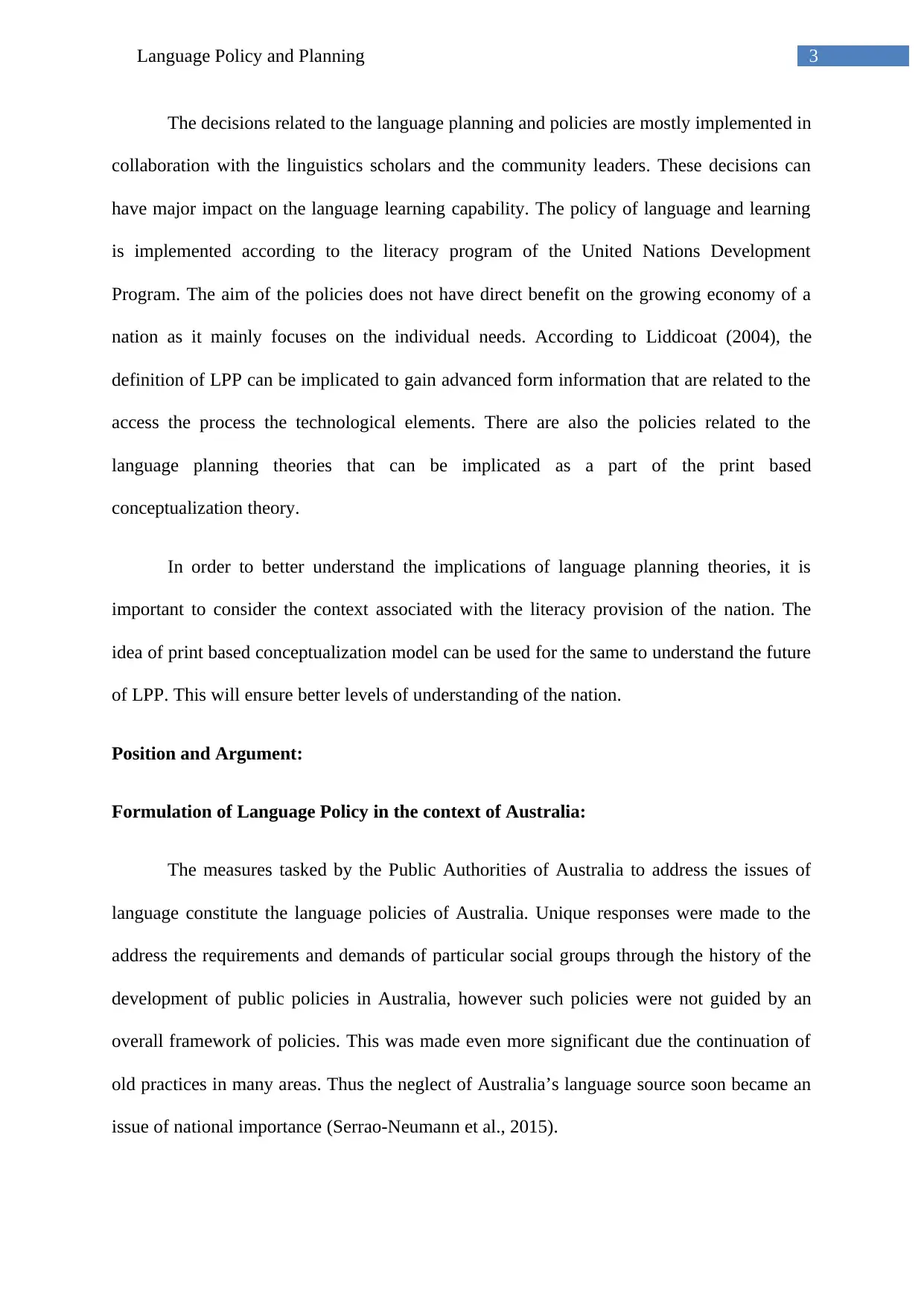
3Language Policy and Planning
The decisions related to the language planning and policies are mostly implemented in
collaboration with the linguistics scholars and the community leaders. These decisions can
have major impact on the language learning capability. The policy of language and learning
is implemented according to the literacy program of the United Nations Development
Program. The aim of the policies does not have direct benefit on the growing economy of a
nation as it mainly focuses on the individual needs. According to Liddicoat (2004), the
definition of LPP can be implicated to gain advanced form information that are related to the
access the process the technological elements. There are also the policies related to the
language planning theories that can be implicated as a part of the print based
conceptualization theory.
In order to better understand the implications of language planning theories, it is
important to consider the context associated with the literacy provision of the nation. The
idea of print based conceptualization model can be used for the same to understand the future
of LPP. This will ensure better levels of understanding of the nation.
Position and Argument:
Formulation of Language Policy in the context of Australia:
The measures tasked by the Public Authorities of Australia to address the issues of
language constitute the language policies of Australia. Unique responses were made to the
address the requirements and demands of particular social groups through the history of the
development of public policies in Australia, however such policies were not guided by an
overall framework of policies. This was made even more significant due the continuation of
old practices in many areas. Thus the neglect of Australia’s language source soon became an
issue of national importance (Serrao-Neumann et al., 2015).
The decisions related to the language planning and policies are mostly implemented in
collaboration with the linguistics scholars and the community leaders. These decisions can
have major impact on the language learning capability. The policy of language and learning
is implemented according to the literacy program of the United Nations Development
Program. The aim of the policies does not have direct benefit on the growing economy of a
nation as it mainly focuses on the individual needs. According to Liddicoat (2004), the
definition of LPP can be implicated to gain advanced form information that are related to the
access the process the technological elements. There are also the policies related to the
language planning theories that can be implicated as a part of the print based
conceptualization theory.
In order to better understand the implications of language planning theories, it is
important to consider the context associated with the literacy provision of the nation. The
idea of print based conceptualization model can be used for the same to understand the future
of LPP. This will ensure better levels of understanding of the nation.
Position and Argument:
Formulation of Language Policy in the context of Australia:
The measures tasked by the Public Authorities of Australia to address the issues of
language constitute the language policies of Australia. Unique responses were made to the
address the requirements and demands of particular social groups through the history of the
development of public policies in Australia, however such policies were not guided by an
overall framework of policies. This was made even more significant due the continuation of
old practices in many areas. Thus the neglect of Australia’s language source soon became an
issue of national importance (Serrao-Neumann et al., 2015).
Paraphrase This Document
Need a fresh take? Get an instant paraphrase of this document with our AI Paraphraser
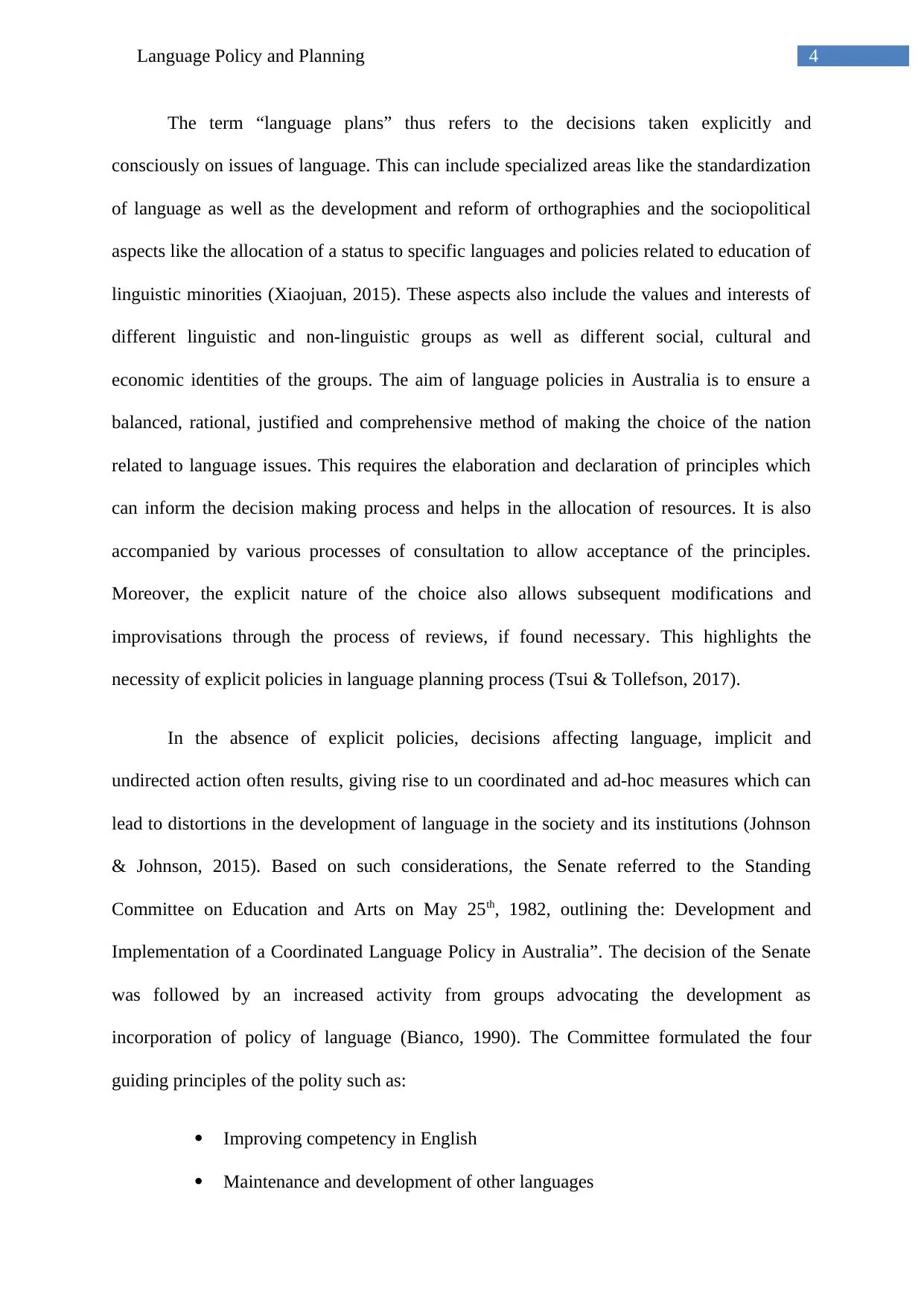
4Language Policy and Planning
The term “language plans” thus refers to the decisions taken explicitly and
consciously on issues of language. This can include specialized areas like the standardization
of language as well as the development and reform of orthographies and the sociopolitical
aspects like the allocation of a status to specific languages and policies related to education of
linguistic minorities (Xiaojuan, 2015). These aspects also include the values and interests of
different linguistic and non-linguistic groups as well as different social, cultural and
economic identities of the groups. The aim of language policies in Australia is to ensure a
balanced, rational, justified and comprehensive method of making the choice of the nation
related to language issues. This requires the elaboration and declaration of principles which
can inform the decision making process and helps in the allocation of resources. It is also
accompanied by various processes of consultation to allow acceptance of the principles.
Moreover, the explicit nature of the choice also allows subsequent modifications and
improvisations through the process of reviews, if found necessary. This highlights the
necessity of explicit policies in language planning process (Tsui & Tollefson, 2017).
In the absence of explicit policies, decisions affecting language, implicit and
undirected action often results, giving rise to un coordinated and ad-hoc measures which can
lead to distortions in the development of language in the society and its institutions (Johnson
& Johnson, 2015). Based on such considerations, the Senate referred to the Standing
Committee on Education and Arts on May 25th, 1982, outlining the: Development and
Implementation of a Coordinated Language Policy in Australia”. The decision of the Senate
was followed by an increased activity from groups advocating the development as
incorporation of policy of language (Bianco, 1990). The Committee formulated the four
guiding principles of the polity such as:
Improving competency in English
Maintenance and development of other languages
The term “language plans” thus refers to the decisions taken explicitly and
consciously on issues of language. This can include specialized areas like the standardization
of language as well as the development and reform of orthographies and the sociopolitical
aspects like the allocation of a status to specific languages and policies related to education of
linguistic minorities (Xiaojuan, 2015). These aspects also include the values and interests of
different linguistic and non-linguistic groups as well as different social, cultural and
economic identities of the groups. The aim of language policies in Australia is to ensure a
balanced, rational, justified and comprehensive method of making the choice of the nation
related to language issues. This requires the elaboration and declaration of principles which
can inform the decision making process and helps in the allocation of resources. It is also
accompanied by various processes of consultation to allow acceptance of the principles.
Moreover, the explicit nature of the choice also allows subsequent modifications and
improvisations through the process of reviews, if found necessary. This highlights the
necessity of explicit policies in language planning process (Tsui & Tollefson, 2017).
In the absence of explicit policies, decisions affecting language, implicit and
undirected action often results, giving rise to un coordinated and ad-hoc measures which can
lead to distortions in the development of language in the society and its institutions (Johnson
& Johnson, 2015). Based on such considerations, the Senate referred to the Standing
Committee on Education and Arts on May 25th, 1982, outlining the: Development and
Implementation of a Coordinated Language Policy in Australia”. The decision of the Senate
was followed by an increased activity from groups advocating the development as
incorporation of policy of language (Bianco, 1990). The Committee formulated the four
guiding principles of the polity such as:
Improving competency in English
Maintenance and development of other languages
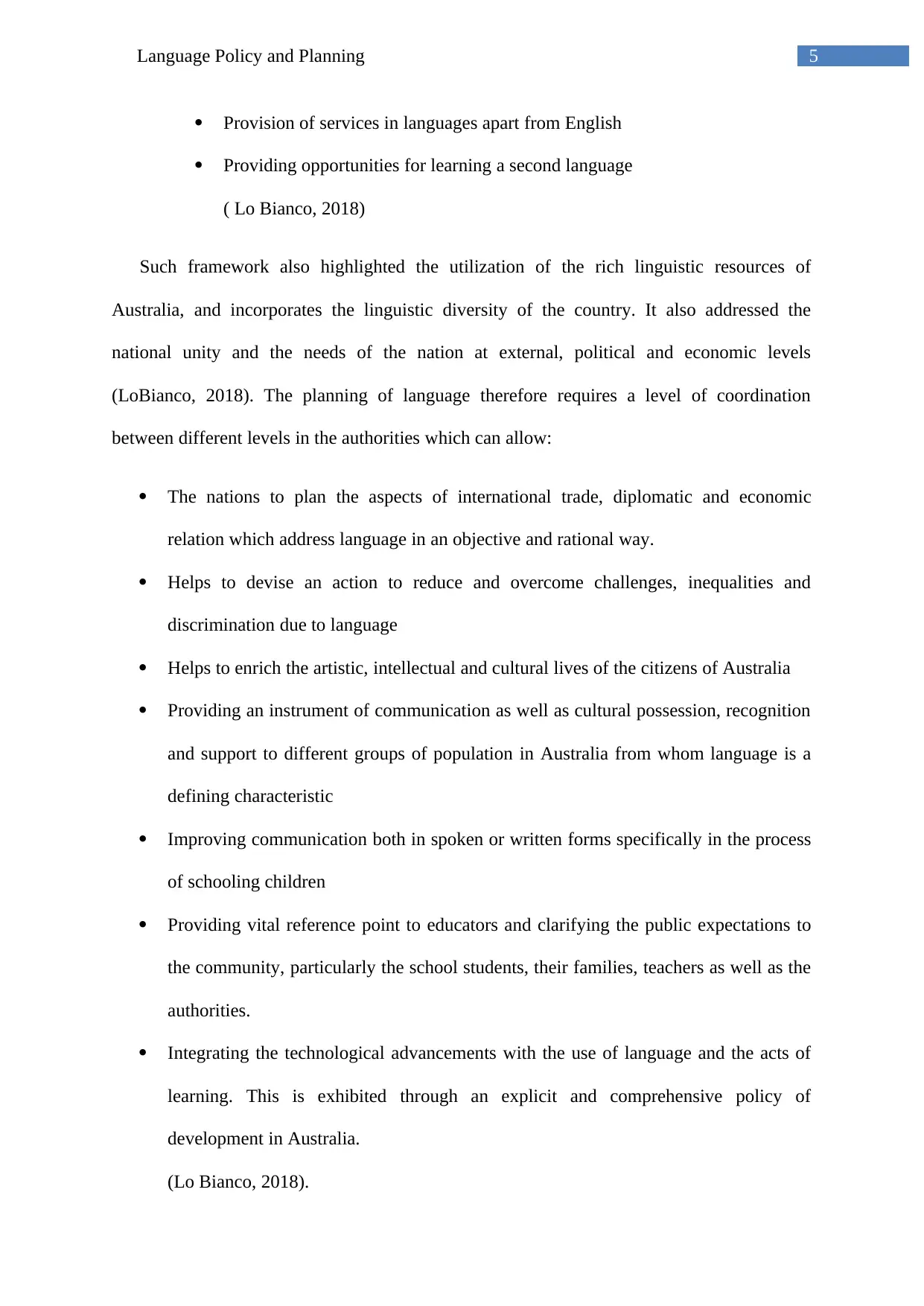
5Language Policy and Planning
Provision of services in languages apart from English
Providing opportunities for learning a second language
( Lo Bianco, 2018)
Such framework also highlighted the utilization of the rich linguistic resources of
Australia, and incorporates the linguistic diversity of the country. It also addressed the
national unity and the needs of the nation at external, political and economic levels
(LoBianco, 2018). The planning of language therefore requires a level of coordination
between different levels in the authorities which can allow:
The nations to plan the aspects of international trade, diplomatic and economic
relation which address language in an objective and rational way.
Helps to devise an action to reduce and overcome challenges, inequalities and
discrimination due to language
Helps to enrich the artistic, intellectual and cultural lives of the citizens of Australia
Providing an instrument of communication as well as cultural possession, recognition
and support to different groups of population in Australia from whom language is a
defining characteristic
Improving communication both in spoken or written forms specifically in the process
of schooling children
Providing vital reference point to educators and clarifying the public expectations to
the community, particularly the school students, their families, teachers as well as the
authorities.
Integrating the technological advancements with the use of language and the acts of
learning. This is exhibited through an explicit and comprehensive policy of
development in Australia.
(Lo Bianco, 2018).
Provision of services in languages apart from English
Providing opportunities for learning a second language
( Lo Bianco, 2018)
Such framework also highlighted the utilization of the rich linguistic resources of
Australia, and incorporates the linguistic diversity of the country. It also addressed the
national unity and the needs of the nation at external, political and economic levels
(LoBianco, 2018). The planning of language therefore requires a level of coordination
between different levels in the authorities which can allow:
The nations to plan the aspects of international trade, diplomatic and economic
relation which address language in an objective and rational way.
Helps to devise an action to reduce and overcome challenges, inequalities and
discrimination due to language
Helps to enrich the artistic, intellectual and cultural lives of the citizens of Australia
Providing an instrument of communication as well as cultural possession, recognition
and support to different groups of population in Australia from whom language is a
defining characteristic
Improving communication both in spoken or written forms specifically in the process
of schooling children
Providing vital reference point to educators and clarifying the public expectations to
the community, particularly the school students, their families, teachers as well as the
authorities.
Integrating the technological advancements with the use of language and the acts of
learning. This is exhibited through an explicit and comprehensive policy of
development in Australia.
(Lo Bianco, 2018).
⊘ This is a preview!⊘
Do you want full access?
Subscribe today to unlock all pages.

Trusted by 1+ million students worldwide
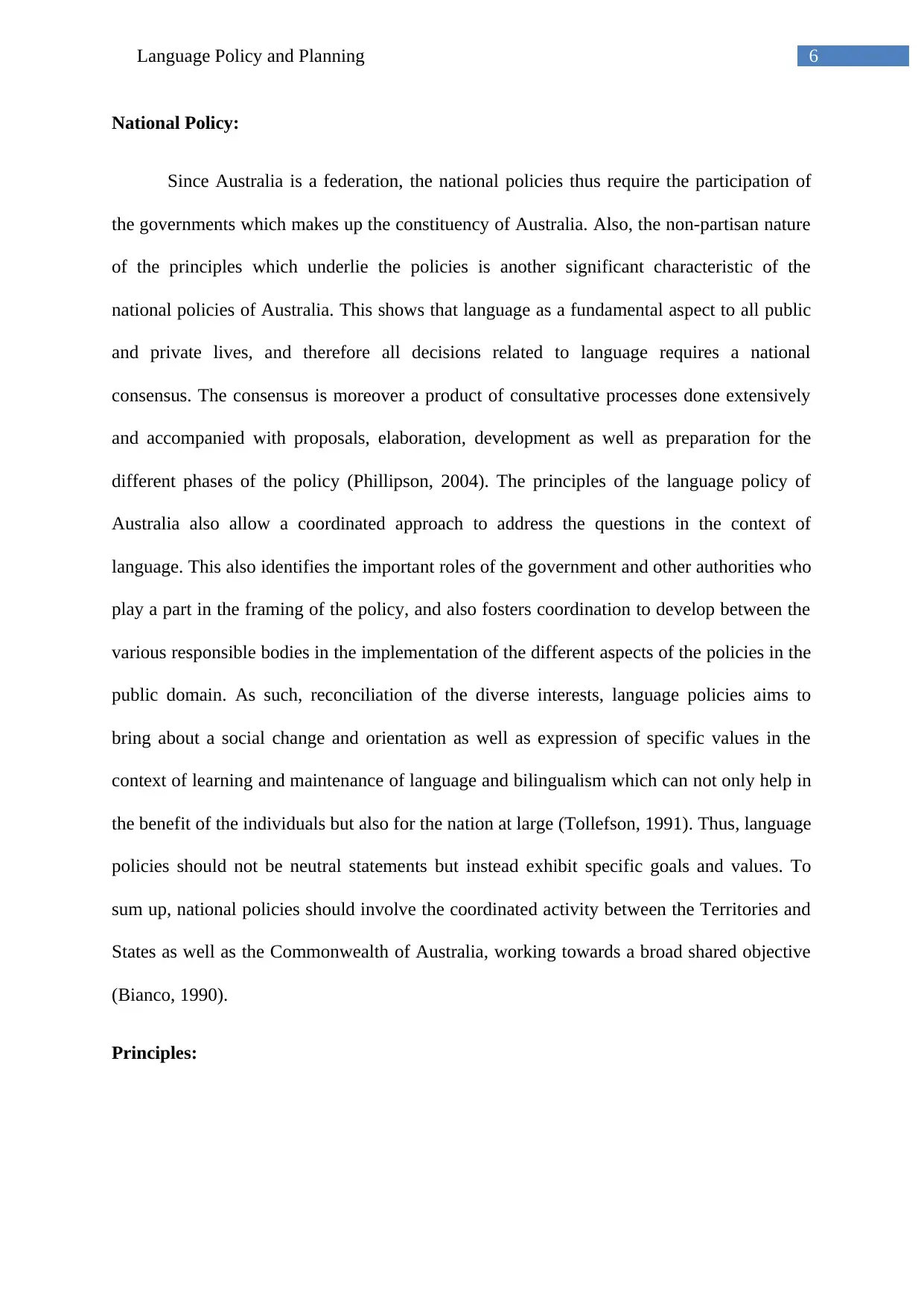
6Language Policy and Planning
National Policy:
Since Australia is a federation, the national policies thus require the participation of
the governments which makes up the constituency of Australia. Also, the non-partisan nature
of the principles which underlie the policies is another significant characteristic of the
national policies of Australia. This shows that language as a fundamental aspect to all public
and private lives, and therefore all decisions related to language requires a national
consensus. The consensus is moreover a product of consultative processes done extensively
and accompanied with proposals, elaboration, development as well as preparation for the
different phases of the policy (Phillipson, 2004). The principles of the language policy of
Australia also allow a coordinated approach to address the questions in the context of
language. This also identifies the important roles of the government and other authorities who
play a part in the framing of the policy, and also fosters coordination to develop between the
various responsible bodies in the implementation of the different aspects of the policies in the
public domain. As such, reconciliation of the diverse interests, language policies aims to
bring about a social change and orientation as well as expression of specific values in the
context of learning and maintenance of language and bilingualism which can not only help in
the benefit of the individuals but also for the nation at large (Tollefson, 1991). Thus, language
policies should not be neutral statements but instead exhibit specific goals and values. To
sum up, national policies should involve the coordinated activity between the Territories and
States as well as the Commonwealth of Australia, working towards a broad shared objective
(Bianco, 1990).
Principles:
National Policy:
Since Australia is a federation, the national policies thus require the participation of
the governments which makes up the constituency of Australia. Also, the non-partisan nature
of the principles which underlie the policies is another significant characteristic of the
national policies of Australia. This shows that language as a fundamental aspect to all public
and private lives, and therefore all decisions related to language requires a national
consensus. The consensus is moreover a product of consultative processes done extensively
and accompanied with proposals, elaboration, development as well as preparation for the
different phases of the policy (Phillipson, 2004). The principles of the language policy of
Australia also allow a coordinated approach to address the questions in the context of
language. This also identifies the important roles of the government and other authorities who
play a part in the framing of the policy, and also fosters coordination to develop between the
various responsible bodies in the implementation of the different aspects of the policies in the
public domain. As such, reconciliation of the diverse interests, language policies aims to
bring about a social change and orientation as well as expression of specific values in the
context of learning and maintenance of language and bilingualism which can not only help in
the benefit of the individuals but also for the nation at large (Tollefson, 1991). Thus, language
policies should not be neutral statements but instead exhibit specific goals and values. To
sum up, national policies should involve the coordinated activity between the Territories and
States as well as the Commonwealth of Australia, working towards a broad shared objective
(Bianco, 1990).
Principles:
Paraphrase This Document
Need a fresh take? Get an instant paraphrase of this document with our AI Paraphraser
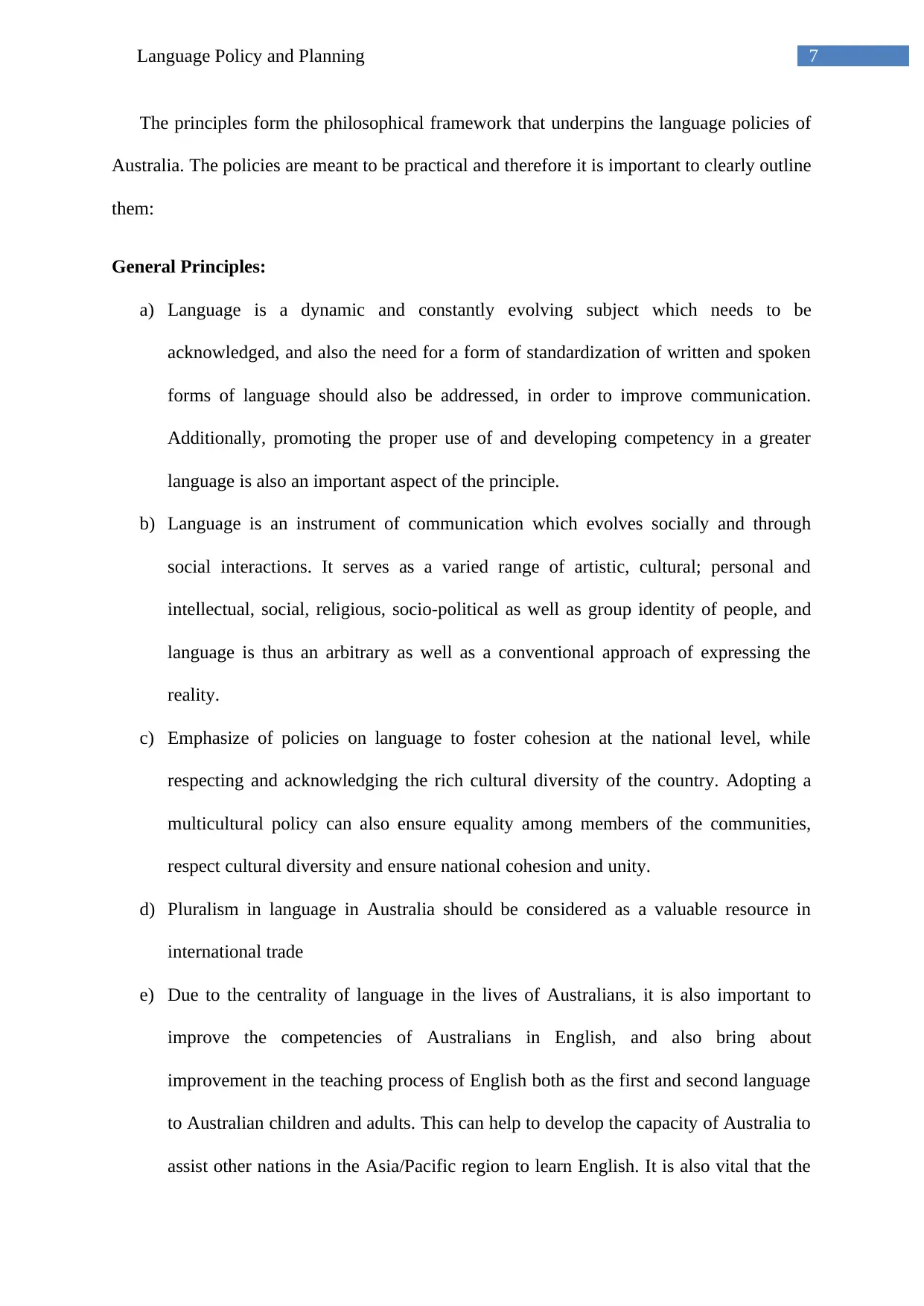
7Language Policy and Planning
The principles form the philosophical framework that underpins the language policies of
Australia. The policies are meant to be practical and therefore it is important to clearly outline
them:
General Principles:
a) Language is a dynamic and constantly evolving subject which needs to be
acknowledged, and also the need for a form of standardization of written and spoken
forms of language should also be addressed, in order to improve communication.
Additionally, promoting the proper use of and developing competency in a greater
language is also an important aspect of the principle.
b) Language is an instrument of communication which evolves socially and through
social interactions. It serves as a varied range of artistic, cultural; personal and
intellectual, social, religious, socio-political as well as group identity of people, and
language is thus an arbitrary as well as a conventional approach of expressing the
reality.
c) Emphasize of policies on language to foster cohesion at the national level, while
respecting and acknowledging the rich cultural diversity of the country. Adopting a
multicultural policy can also ensure equality among members of the communities,
respect cultural diversity and ensure national cohesion and unity.
d) Pluralism in language in Australia should be considered as a valuable resource in
international trade
e) Due to the centrality of language in the lives of Australians, it is also important to
improve the competencies of Australians in English, and also bring about
improvement in the teaching process of English both as the first and second language
to Australian children and adults. This can help to develop the capacity of Australia to
assist other nations in the Asia/Pacific region to learn English. It is also vital that the
The principles form the philosophical framework that underpins the language policies of
Australia. The policies are meant to be practical and therefore it is important to clearly outline
them:
General Principles:
a) Language is a dynamic and constantly evolving subject which needs to be
acknowledged, and also the need for a form of standardization of written and spoken
forms of language should also be addressed, in order to improve communication.
Additionally, promoting the proper use of and developing competency in a greater
language is also an important aspect of the principle.
b) Language is an instrument of communication which evolves socially and through
social interactions. It serves as a varied range of artistic, cultural; personal and
intellectual, social, religious, socio-political as well as group identity of people, and
language is thus an arbitrary as well as a conventional approach of expressing the
reality.
c) Emphasize of policies on language to foster cohesion at the national level, while
respecting and acknowledging the rich cultural diversity of the country. Adopting a
multicultural policy can also ensure equality among members of the communities,
respect cultural diversity and ensure national cohesion and unity.
d) Pluralism in language in Australia should be considered as a valuable resource in
international trade
e) Due to the centrality of language in the lives of Australians, it is also important to
improve the competencies of Australians in English, and also bring about
improvement in the teaching process of English both as the first and second language
to Australian children and adults. This can help to develop the capacity of Australia to
assist other nations in the Asia/Pacific region to learn English. It is also vital that the
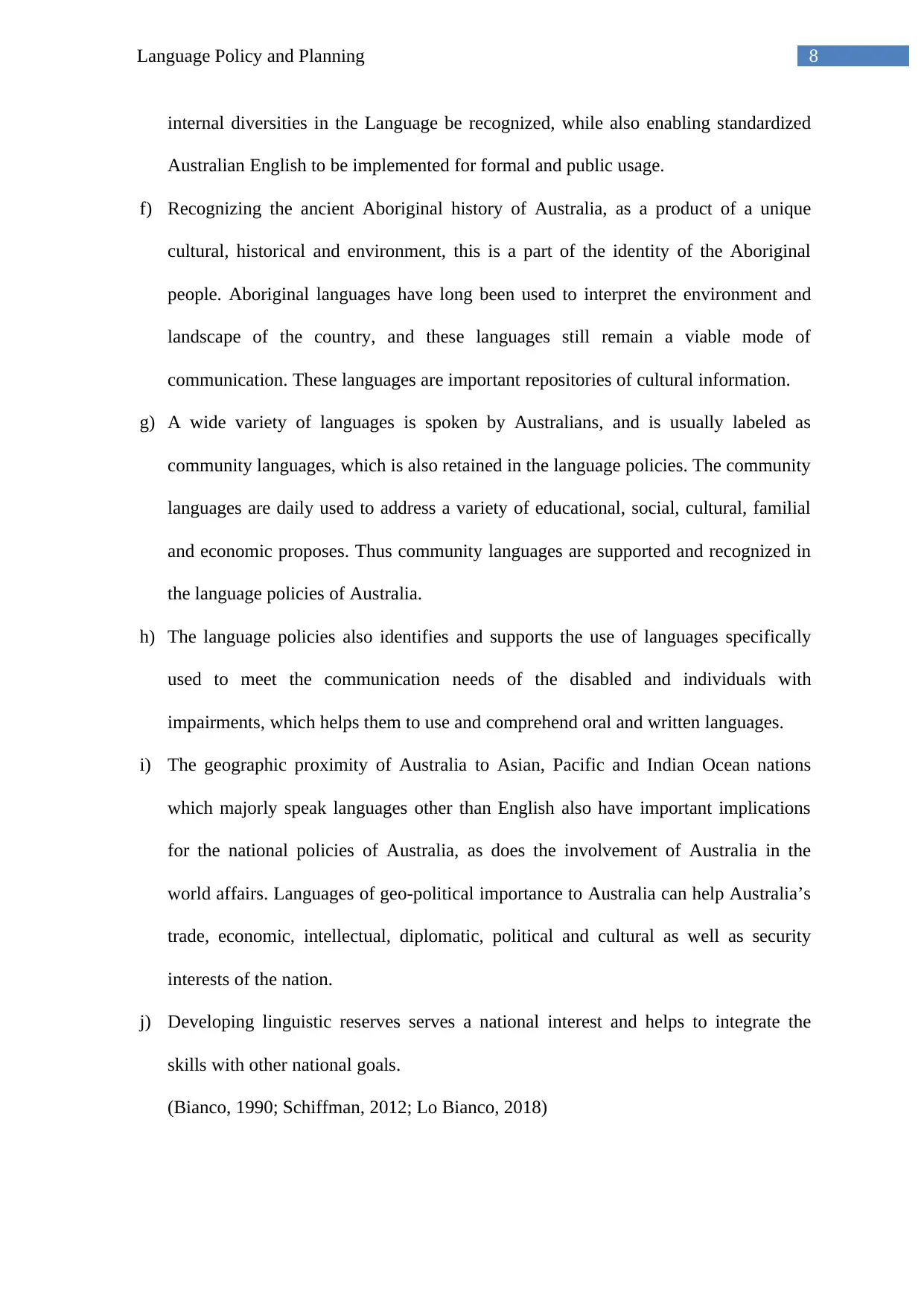
8Language Policy and Planning
internal diversities in the Language be recognized, while also enabling standardized
Australian English to be implemented for formal and public usage.
f) Recognizing the ancient Aboriginal history of Australia, as a product of a unique
cultural, historical and environment, this is a part of the identity of the Aboriginal
people. Aboriginal languages have long been used to interpret the environment and
landscape of the country, and these languages still remain a viable mode of
communication. These languages are important repositories of cultural information.
g) A wide variety of languages is spoken by Australians, and is usually labeled as
community languages, which is also retained in the language policies. The community
languages are daily used to address a variety of educational, social, cultural, familial
and economic proposes. Thus community languages are supported and recognized in
the language policies of Australia.
h) The language policies also identifies and supports the use of languages specifically
used to meet the communication needs of the disabled and individuals with
impairments, which helps them to use and comprehend oral and written languages.
i) The geographic proximity of Australia to Asian, Pacific and Indian Ocean nations
which majorly speak languages other than English also have important implications
for the national policies of Australia, as does the involvement of Australia in the
world affairs. Languages of geo-political importance to Australia can help Australia’s
trade, economic, intellectual, diplomatic, political and cultural as well as security
interests of the nation.
j) Developing linguistic reserves serves a national interest and helps to integrate the
skills with other national goals.
(Bianco, 1990; Schiffman, 2012; Lo Bianco, 2018)
internal diversities in the Language be recognized, while also enabling standardized
Australian English to be implemented for formal and public usage.
f) Recognizing the ancient Aboriginal history of Australia, as a product of a unique
cultural, historical and environment, this is a part of the identity of the Aboriginal
people. Aboriginal languages have long been used to interpret the environment and
landscape of the country, and these languages still remain a viable mode of
communication. These languages are important repositories of cultural information.
g) A wide variety of languages is spoken by Australians, and is usually labeled as
community languages, which is also retained in the language policies. The community
languages are daily used to address a variety of educational, social, cultural, familial
and economic proposes. Thus community languages are supported and recognized in
the language policies of Australia.
h) The language policies also identifies and supports the use of languages specifically
used to meet the communication needs of the disabled and individuals with
impairments, which helps them to use and comprehend oral and written languages.
i) The geographic proximity of Australia to Asian, Pacific and Indian Ocean nations
which majorly speak languages other than English also have important implications
for the national policies of Australia, as does the involvement of Australia in the
world affairs. Languages of geo-political importance to Australia can help Australia’s
trade, economic, intellectual, diplomatic, political and cultural as well as security
interests of the nation.
j) Developing linguistic reserves serves a national interest and helps to integrate the
skills with other national goals.
(Bianco, 1990; Schiffman, 2012; Lo Bianco, 2018)
⊘ This is a preview!⊘
Do you want full access?
Subscribe today to unlock all pages.

Trusted by 1+ million students worldwide
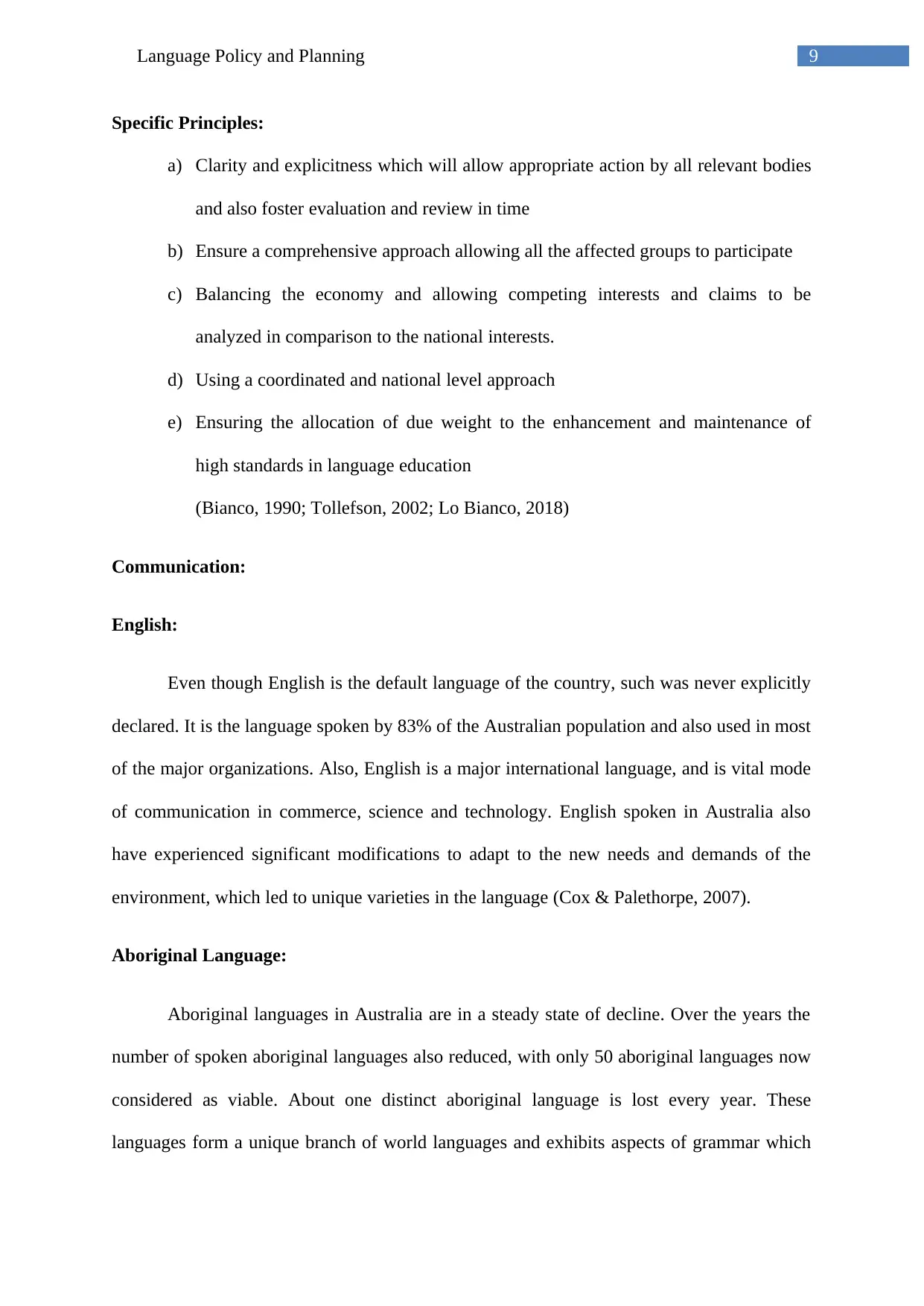
9Language Policy and Planning
Specific Principles:
a) Clarity and explicitness which will allow appropriate action by all relevant bodies
and also foster evaluation and review in time
b) Ensure a comprehensive approach allowing all the affected groups to participate
c) Balancing the economy and allowing competing interests and claims to be
analyzed in comparison to the national interests.
d) Using a coordinated and national level approach
e) Ensuring the allocation of due weight to the enhancement and maintenance of
high standards in language education
(Bianco, 1990; Tollefson, 2002; Lo Bianco, 2018)
Communication:
English:
Even though English is the default language of the country, such was never explicitly
declared. It is the language spoken by 83% of the Australian population and also used in most
of the major organizations. Also, English is a major international language, and is vital mode
of communication in commerce, science and technology. English spoken in Australia also
have experienced significant modifications to adapt to the new needs and demands of the
environment, which led to unique varieties in the language (Cox & Palethorpe, 2007).
Aboriginal Language:
Aboriginal languages in Australia are in a steady state of decline. Over the years the
number of spoken aboriginal languages also reduced, with only 50 aboriginal languages now
considered as viable. About one distinct aboriginal language is lost every year. These
languages form a unique branch of world languages and exhibits aspects of grammar which
Specific Principles:
a) Clarity and explicitness which will allow appropriate action by all relevant bodies
and also foster evaluation and review in time
b) Ensure a comprehensive approach allowing all the affected groups to participate
c) Balancing the economy and allowing competing interests and claims to be
analyzed in comparison to the national interests.
d) Using a coordinated and national level approach
e) Ensuring the allocation of due weight to the enhancement and maintenance of
high standards in language education
(Bianco, 1990; Tollefson, 2002; Lo Bianco, 2018)
Communication:
English:
Even though English is the default language of the country, such was never explicitly
declared. It is the language spoken by 83% of the Australian population and also used in most
of the major organizations. Also, English is a major international language, and is vital mode
of communication in commerce, science and technology. English spoken in Australia also
have experienced significant modifications to adapt to the new needs and demands of the
environment, which led to unique varieties in the language (Cox & Palethorpe, 2007).
Aboriginal Language:
Aboriginal languages in Australia are in a steady state of decline. Over the years the
number of spoken aboriginal languages also reduced, with only 50 aboriginal languages now
considered as viable. About one distinct aboriginal language is lost every year. These
languages form a unique branch of world languages and exhibits aspects of grammar which
Paraphrase This Document
Need a fresh take? Get an instant paraphrase of this document with our AI Paraphraser
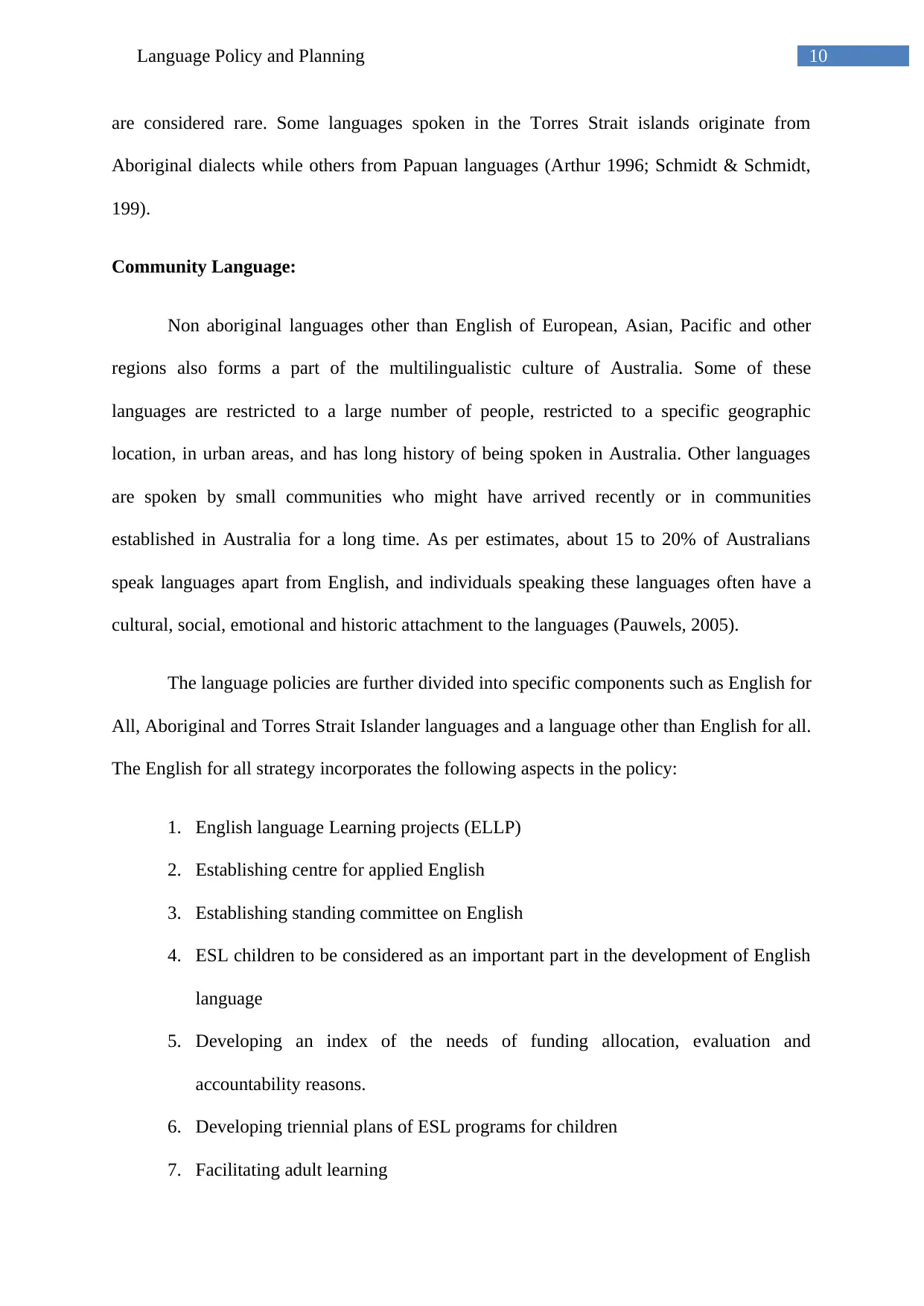
10Language Policy and Planning
are considered rare. Some languages spoken in the Torres Strait islands originate from
Aboriginal dialects while others from Papuan languages (Arthur 1996; Schmidt & Schmidt,
199).
Community Language:
Non aboriginal languages other than English of European, Asian, Pacific and other
regions also forms a part of the multilingualistic culture of Australia. Some of these
languages are restricted to a large number of people, restricted to a specific geographic
location, in urban areas, and has long history of being spoken in Australia. Other languages
are spoken by small communities who might have arrived recently or in communities
established in Australia for a long time. As per estimates, about 15 to 20% of Australians
speak languages apart from English, and individuals speaking these languages often have a
cultural, social, emotional and historic attachment to the languages (Pauwels, 2005).
The language policies are further divided into specific components such as English for
All, Aboriginal and Torres Strait Islander languages and a language other than English for all.
The English for all strategy incorporates the following aspects in the policy:
1. English language Learning projects (ELLP)
2. Establishing centre for applied English
3. Establishing standing committee on English
4. ESL children to be considered as an important part in the development of English
language
5. Developing an index of the needs of funding allocation, evaluation and
accountability reasons.
6. Developing triennial plans of ESL programs for children
7. Facilitating adult learning
are considered rare. Some languages spoken in the Torres Strait islands originate from
Aboriginal dialects while others from Papuan languages (Arthur 1996; Schmidt & Schmidt,
199).
Community Language:
Non aboriginal languages other than English of European, Asian, Pacific and other
regions also forms a part of the multilingualistic culture of Australia. Some of these
languages are restricted to a large number of people, restricted to a specific geographic
location, in urban areas, and has long history of being spoken in Australia. Other languages
are spoken by small communities who might have arrived recently or in communities
established in Australia for a long time. As per estimates, about 15 to 20% of Australians
speak languages apart from English, and individuals speaking these languages often have a
cultural, social, emotional and historic attachment to the languages (Pauwels, 2005).
The language policies are further divided into specific components such as English for
All, Aboriginal and Torres Strait Islander languages and a language other than English for all.
The English for all strategy incorporates the following aspects in the policy:
1. English language Learning projects (ELLP)
2. Establishing centre for applied English
3. Establishing standing committee on English
4. ESL children to be considered as an important part in the development of English
language
5. Developing an index of the needs of funding allocation, evaluation and
accountability reasons.
6. Developing triennial plans of ESL programs for children
7. Facilitating adult learning
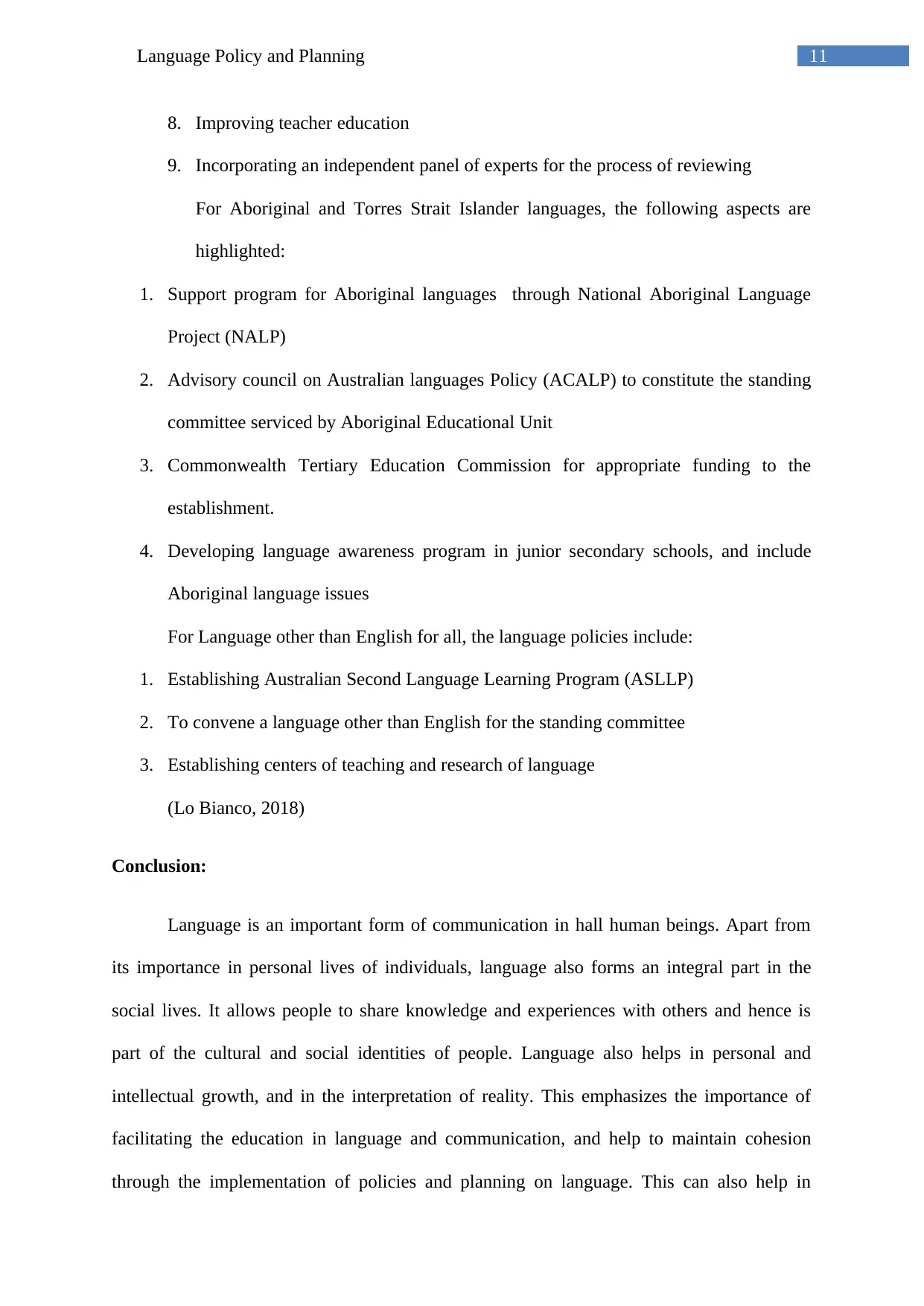
11Language Policy and Planning
8. Improving teacher education
9. Incorporating an independent panel of experts for the process of reviewing
For Aboriginal and Torres Strait Islander languages, the following aspects are
highlighted:
1. Support program for Aboriginal languages through National Aboriginal Language
Project (NALP)
2. Advisory council on Australian languages Policy (ACALP) to constitute the standing
committee serviced by Aboriginal Educational Unit
3. Commonwealth Tertiary Education Commission for appropriate funding to the
establishment.
4. Developing language awareness program in junior secondary schools, and include
Aboriginal language issues
For Language other than English for all, the language policies include:
1. Establishing Australian Second Language Learning Program (ASLLP)
2. To convene a language other than English for the standing committee
3. Establishing centers of teaching and research of language
(Lo Bianco, 2018)
Conclusion:
Language is an important form of communication in hall human beings. Apart from
its importance in personal lives of individuals, language also forms an integral part in the
social lives. It allows people to share knowledge and experiences with others and hence is
part of the cultural and social identities of people. Language also helps in personal and
intellectual growth, and in the interpretation of reality. This emphasizes the importance of
facilitating the education in language and communication, and help to maintain cohesion
through the implementation of policies and planning on language. This can also help in
8. Improving teacher education
9. Incorporating an independent panel of experts for the process of reviewing
For Aboriginal and Torres Strait Islander languages, the following aspects are
highlighted:
1. Support program for Aboriginal languages through National Aboriginal Language
Project (NALP)
2. Advisory council on Australian languages Policy (ACALP) to constitute the standing
committee serviced by Aboriginal Educational Unit
3. Commonwealth Tertiary Education Commission for appropriate funding to the
establishment.
4. Developing language awareness program in junior secondary schools, and include
Aboriginal language issues
For Language other than English for all, the language policies include:
1. Establishing Australian Second Language Learning Program (ASLLP)
2. To convene a language other than English for the standing committee
3. Establishing centers of teaching and research of language
(Lo Bianco, 2018)
Conclusion:
Language is an important form of communication in hall human beings. Apart from
its importance in personal lives of individuals, language also forms an integral part in the
social lives. It allows people to share knowledge and experiences with others and hence is
part of the cultural and social identities of people. Language also helps in personal and
intellectual growth, and in the interpretation of reality. This emphasizes the importance of
facilitating the education in language and communication, and help to maintain cohesion
through the implementation of policies and planning on language. This can also help in
⊘ This is a preview!⊘
Do you want full access?
Subscribe today to unlock all pages.

Trusted by 1+ million students worldwide
1 out of 16
Related Documents
Your All-in-One AI-Powered Toolkit for Academic Success.
+13062052269
info@desklib.com
Available 24*7 on WhatsApp / Email
![[object Object]](/_next/static/media/star-bottom.7253800d.svg)
Unlock your academic potential
Copyright © 2020–2025 A2Z Services. All Rights Reserved. Developed and managed by ZUCOL.





